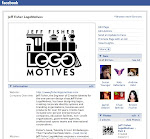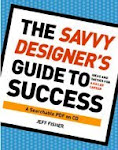by Jeff Fisher, Engineer of Creative Identity, Jeff Fisher LogoMotives
 It's a law of graphic design: Clients are capable of extraordinary stupidity. In March 2003, I started a discussion thread about "stupid client tricks" on the HOWdesign.com forum. More than 100 posts later, it became evident that stupid clients are the norm and that designers need methods for dealing with them in a positive manner.
It's a law of graphic design: Clients are capable of extraordinary stupidity. In March 2003, I started a discussion thread about "stupid client tricks" on the HOWdesign.com forum. More than 100 posts later, it became evident that stupid clients are the norm and that designers need methods for dealing with them in a positive manner.
At times, working with challenging clients is similar to attempting to coordinate the wild-horse race at a rodeo, or playing the ringmaster at an old-fashioned Wild West show. There are too many participants, lots of bucking, riders being thrown in every direction, a variety of obstacles in the way, vast amounts of dirt tossed about—and even a little manure to avoid.
Heading 'Em Off at the Pass
It's possible to avoid potential stupid client tricks before they actually happen by preparing a program for the upcoming spectacle.
Starting a project on the same page as your client is a no-brainer. In her book Graphically Speaking (HOW Design Books), author Lisa Buchanan, a Cincinnati-based designer, provides a sample survey of questions to present to a client prior to beginning a project. The questionnaire evolved out of responses from more than 50 design firms that were asked, "What questions do you typically discuss with a client?" I've used a similar customized list of questions with clients for many years.
Francesca De Lorme, of ARTiculate Communications & Design in East Burke, VT, says: "When clients insist upon having their own way, we always treat them with respect and listen to what they have to say while attempting to do the following: 1) Explain concisely what problems will result from their insistence; and 2) show them examples of the type of problem that will result if they insist on doing it their way.
"We maintain files of 'the good, the bad and the ugly' that we've collected over the years for just that purpose, and find that showing our clients someone else's mistakes can sometimes help them avoid making their own," she continues. "About 85% of the time, this solves the problem."
"Most stupid client tricks I see are in requests for design elements and concepts," says Shawn Parker of Top Frog Graphics in Denver. "If clients want something questionable, do a mock-up of how you think it should be done. They'll most likely see that there's a better way to do it; at the very least, you'll probably end up at a compromise between the good and bad."
Rounding Up the Herd
Bringing a client who's drifting off to the frontiers of Stupid Land back to the major issues that need to be addressed on a project often takes more than a lasso and a cattle prod. In roping clients back into focusing on a project, Triad Design Group in Boonton, NJ, turns the tables by reiterating information already provided by the customer. "We remind them of the objectives that they provided at the onset of the project," say Christina Laios and Rob Lembo, Triad partners. "This works really well because they will rarely contradict themselves. It also reinforces their own importance in the project and actually makes them feel smarter."
Presenting the financial implications of real or perceived stupidity to a client is a great way to get his attention and get a project back on track. (Project fees should be exponentially escalated in direct correlation to the overt stupidity of the client.) "Bad ideas are often best exposed by showing how they'll affect the bottom line," Parker says.
Rumble at the Chuck Wagon
That rumbling in your stomach isn't necessarily hunger or gastrointestinal distress. Often it's the built-in alarm know as "gut instinct" demanding your immediate attention. After 20 years as a designer, I've finally learned to trust my instincts, and I've saved myself from a lot of stress, grief and temporary insanity by listening to that inner voice when it yells, "Head for the hills!"
That sixth sense comes primarily from watching for patterns in client behavior. "I think my gut instincts have developed over time, and I can usually predict, from a pre-project needs-assessment meeting with the client, which clients I'll likely find to be difficult to deal with," De Lorme says. "I've also learned about some particular themes of stupid client tricks that repeat themselves, and I try to head them off in advance."
Laios and Lembo agree: "No matter how much we want to believe that a client or situation is going to be different than before, when we listen to our gut instincts, we avoid a lot of problems."
While designers often bump up fees to cover pain-in-the-butt clients, some customers aren't even worth that. "Sometimes you know it's gonna be a money-losing situation or that you just don't have the brain capacity to deal with it at a particular point in time," Parker says. "There's nothing wrong with letting a job go for the sake of your personal mental health."
High Noon
A shootout is not the answer to most disagreements with argumentative clients. You need to pick your battles.
Recently, I knew I was in trouble when a client asked how he could maintain the unusual position of the company's logo when importing it into any software program. Still, I wasn't prepared when the client asked me to rotate the logo by 2 1/2 degrees. If such a precise request doesn't qualify as a stupid client trick, I don't know what does. I know it was petty but, to satisfy nothing more than my own ego, I rotated the artwork just 1 1/4 degrees and presented the finished logo to a thrilled client. The issue wasn't worth an all-out battle with the client. With his request, he got the satisfaction of playing art director. My action allows me a silly little smile every time I see that company's identity.
"As long as I believe doing it the client's way won't completely waste money and it doesn't violate my own ethical values, I'll go ahead and do what the client asks—it's her money and her project," De Lorme says. "If I've given the best ideas for the project and my well-considered professional advice, and she still wants to proceed despite my concerns, then I'll usually go ahead and do what she asks."
Letting Clients Shoot Themselves in the Foot
At times you need to let clients be "right" to prove just how wrong they may be—and the mistakes can be costly.
Years ago, I was hired to create the identity for a luxury hotel. Supposedly, I was hired for my expertise, but the opinion of the facility's interior designer kept getting in my way. The hotel management seemed to value her opinion more than mine. It was as if two bulls were going at each other when it came to the issue of the logo color on the stationery and all other printed items. I had my recommendations. The interior designer felt her selection (a vibrant orange) would work better with the hotel color scheme.
I wasn't going to win this showdown, and I had to step back and let the client (and the interior designer) shoot themselves in both feet. Tens of thousands of pieces were printed and delivered. With that very orange logo, the project was dubbed the "Taco Bell Hotel." The management was mortified by the result and recycled all the printed materials. They reprinted everything using my color recommendations. The client never again questioned my opinion.
Showdown at the OK Corral
Does "OK" really mean all is right in the poker game we call "project management," or does one of the players have an ace up his sleeve? Designers need to know all the players, the cards they hold and who really has the power to play the game. "If there are business partners involved, get signatures from all parties before finalizing the artwork," Parker advises. "We did have one company threaten to refuse payment to us because one principal did something that the other didn't approve of in the course of a project."
Riding Off Into the Sunset
It's not as if the town's not big enough for both you and your client. By projecting confidence, communicating effectively and delivering on your promises, you can show the client you're in control of the project and develop a mutually beneficial relationship. In her book The Graphic Designer's Guide to Clients (Allworth Press), New York City-based designer Ellen Shapiro writes, "You were hired to make the right choices. You should be able to justify those choices if asked. And the answer should make business sense."
Shapiro adds, "And while you're at it, don't fall into the clichZs associated with Ôflaky creatives.' Don't miss deadlines. Show up on time—no, 10 minutes early—for meetings. Be prepared. Look and act businesslike."
By expecting the most of yourself, and subtly demanding the best of your client, a two-person Technicolor ride into the sunset can result—instead of someone ending up buried under a dead tree on Boot Hill.
This article appeared in the April 2004 issue of HOW Magazine and was posted on Commpiled.com in January 2005.
© 2007 Jeff Fisher LogoMotives






